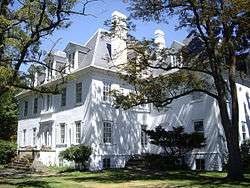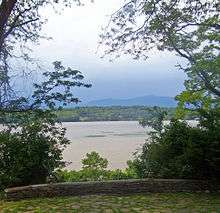Clermont State Historic Site
|
Clermont | |
 | |
  | |
| Location | One mile North of Tivoli, New York |
|---|---|
| Coordinates | 42°05′09″N 73°55′10″W / 42.08583°N 73.91944°WCoordinates: 42°05′09″N 73°55′10″W / 42.08583°N 73.91944°W |
| Built | 1782 |
| Architectural style | Georgian |
| NRHP Reference # | 71000535[1] |
| Significant dates | |
| Added to NRHP | February 18, 1971[1] |
| Designated NHL | November 28, 1972[2] |
The Clermont State Historic Site, also known as the Clermont estate, the Clermont Manor or just Clermont, is a New York State Historic Site in southwestern Columbia County, New York, United States. It protects the former estate of the Livingston family, seven generations of whom lived on the site during more than two centuries.
History
The name Clermont derives from "clear mountain" in French and was inspired by the view of the Catskill Mountains across the Hudson River from the estate.

The estate was established by Robert Livingston following the death of his father, the first Lord of Livingston Manor, in 1728; while most of the manor was inherited by the eldest son Philip Livingston, 13,000 acres (5,300 ha) in the southwest corner, later named Clermont, was willed to Robert. The original house was built about 1740.
Robert Livingston of Clermont died on June 27, 1775 and the estate passed to his son, Robert, who was known as 'Judge Livingston' to distinguish him from his father. Judge Livingston was a member of the New York Provincial Assembly from 1759 to 1768, served as judge of the admiralty court from 1760 to 1763 and was a delegate to the Stamp Act Congress of 1765. He married Margaret Beekman, daughter of Colonel Henry Beekman. Their son, Robert R. Livingston, later known as "Chancellor", served on the committee that drafted the Declaration of Independence. Judge Robert died about six months after his father, on December 9, 1775.
In October 1777, British ships sailed upriver from New York City in support of General John Burgoyne who was north of Albany. That same force had already stormed two forts in the Hudson Highlands and burned Kingston, New York. Major General John Vaughan led a raiding party to Clermont and burned Livingston's home because of the family's role in the rebellion. Margaret Beekman Livingston rebuilt the family home between 1779 and 1782. Robert R. Livingston became the estate's most prominent resident. Chancellor Livingston administered the oath of office to President George Washington, became Secretary of Foreign Affairs, and negotiated the Louisiana Purchase.[3]
He also partnered with Robert Fulton in 1807, to creat the first commercially successful steamboat on the Hudson River, the North River Steamboat (later known as the Clermont), which stopped at the house on its inaugural trip.[4]
The house is now a New York State Historic Site and was designated a United States National Historic Landmark in 1972.[2][5] It is a contributing property to another National Historic Landmark, the Hudson River Historic District.
Although located in the town of Clermont, its mailing address is in the nearby town of Germantown.
See also
- List of National Historic Landmarks in New York
- List of New York State Historic Sites
- National Register of Historic Places listings in Columbia County, New York
References
- 1 2 National Park Service (2007-01-23). "National Register Information System". National Register of Historic Places. National Park Service.
- 1 2 "Clermont". National Historic Landmark summary listing. National Park Service. 2007-09-10.
- ↑ "Clermont State Historic Site", NYS Office of Parks, Recreation, and Historic Preservation
- ↑ "A Brief History of Clermony", Friends of Clermont
- ↑ Charles W. Snell (April 20, 1972). "National Register of Historic Places Inventory: "Clermont"-Livingston Lower Manor" (pdf). National Park Service. and Accompanying 2 photos, exterior, from 1971. (103 KiB)
Further reading
- Dwyer, Michael Middleton (2001). Great Houses of the Hudson River. Preface by Mark Rockefeller. Boston, Mass.: Little, Brown and Company, in association with Historic Hudson Valley. ISBN 0-8212-2767-X.
External links
 Media related to Clermont State Historic Site at Wikimedia Commons
Media related to Clermont State Historic Site at Wikimedia Commons- Friends of Clermont website
- Clermont State Historic Site, NYS Office of Parks, Recreation, and Historic Preservation
- The Clermont Estate
- Historic American Buildings Survey (HABS):
- HABS No. NY-403, "Clermont, Clermont State Historic Site, Tivoli, Dutchess County, NY", 11 photos, 20 measured drawings, 1 photo caption page
- HABS No. NY-403-A, "Clermont, Livingston Farm House", 2 photos, 1 measured drawing

